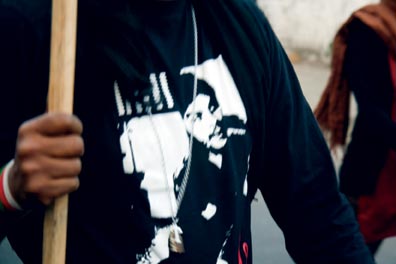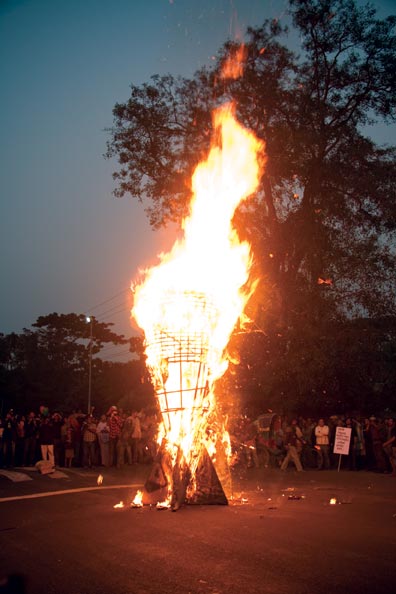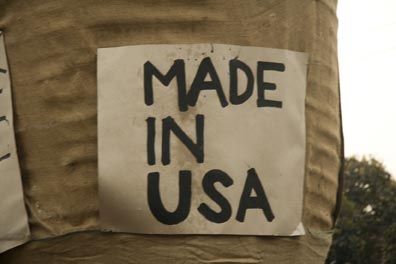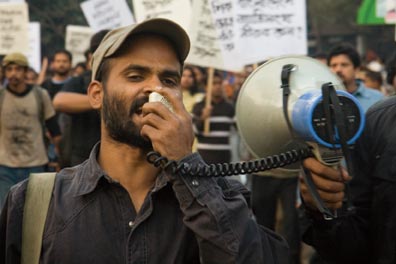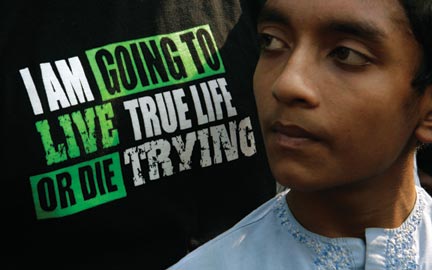Naeem Mohaiemen
Curated by DJ Spooky (Paul Miller)
September 10 – October 31, 2009
Naeem Mohaiemen is a writer and artist working in Dhaka and New York City. He uses text, photo, video and archives to explore histories of the international left, utopia/dystopia slippage, post-partition South Asia, and globally interlinked security panic. Projects include My Mobile Weighs A Ton (militarization);Otondro Prohori, Guarding Who (surveillance); Penn Station Kills Me (monuments); Kazi in Nomansland(amnesia); and Red Ant Motherchod Meet Starfish Nation (military coup).
Working between two countries, Mohaiemen sometimes explores the contradictions between Bengalis in marginal migrant status, and majoritarian (and authoritarian) roles in their own country. He writes on Bangladesh's religious and ethnic minorities for the Ain Salish Kendra Annual Human Rights Report (askbd.org), and on activist blogs (unheardvoice.net/blog). As part of this work, Muslims or Heretics: My Camera Can Lie was a documentary about the problem of multiple audiences. His essays include Islamic Roots of Hip-Hop (Sound Unbound, MIT Press); Beirut: Illusion of a Silver Porsche (Men of the Global South, Zed Books); Why Mahmud Can't be a Pilot (Nobody Passes, Seal Press); Adman Blues Become Artist Liberation (Indian Highway, Serpentine Gallery); Everybody Wants To Be Singapore (La Buena Vida, Carlos Motta, ICA); and the book Collectives in Atomised Time (with Doug Ashford, Idensitat, Spain). Mohaiemen's exhibition at CUE marks his first solo show in New York.
For more information, please visit shobak.org.
DJ Spooky (aka Paul D. Miller, born 1970, Washington DC) is a composer, multimedia artist and writer. His written work has appeared inThe Village Voice, The Source, and Artforum, amongst other publications. Miller's work as a media artist has appeared in the Whitney Biennial, the Venice Biennale for Architecture, the Ludwig Museum in Cologne, Germany; Kunsthalle, Vienna; The Andy Warhol Museum, Pittsburgh and many other museums and galleries. His video installation New York Is Now has been exhibited in the Africa Pavilion of the 52nd Venice Biennial in 2007 and the
Art Basel Miami Beach Fair in 2007. Miller's award-winning book Rhythm Science was published by The MIT Press in 2004 and was followed by Sound Unbound, an anthology of writings on electronic music and digital media, published in 2008. Miller's deep interest in reggae and dub has resulted in a series of compilations, remixes and collections of material from the vaults of the legendary Jamaican label, Trojan Records. Over the course of his career, Miller has collaborated with vast array of recording artists, ranging from Metallica to Chuck D; and Steve Reich to Yoko Ono. Miller's large scale, multimedia performance pieces include Rebirth of a Nation (now on DVD), and Terra Nova: Sinfonia Antarctica, which will be presented by the Brooklyn Academy of Music at the Next Wave Festival in December 2009.
ARTIST'S STATEMENT
Now, every time I photograph a protest rally, there are bits I'm leaving out. At the edge of the lens, beyond the flare zone. The other rule of thirds: representation, exaggeration and omission.
On this day in January 2009, there are two parallel rallies in Dhaka. The one on the university campus organized by my friends and allies: the left student groups, the activist coalitions. The rally ends, as expected, with the ritual burning of the effigy. The words written on the straw figure have not changed much in three decades: there are still warmongers, still imperialism. After the fire goes out, we let everyone start coming into the university area again. Soon traffic is back to its usual chaotic mess.
The other rally is much bigger and more intense. In this one, I find no familiar faces, except among the photographers. Organized by one of the newer Islamist groups, a mixture of Khilafat and traditional left targets. Demanding the withdrawal of Bangladeshi soldiers from UN peacekeeping missions. Fueled by rumors of a future multinational force in Iraq, led by Bangladesh or Pakistan. Whether it would happen or not is almost beside the point. The intention is to resist, and loudly.
The appeal of this new confrontational politics is clear. These are not the Islamists we lazily lampooned in the 1980s. Now their rhetoric has a sharp edge and reality tint. When they argue that gangster capitalism has failed and is dragging down the world, that the global compact is imploding, it's a resonant message for many.
I heard the same message at the other rally as well. All the same targets: Imperialism, United Nations, Multinationals. Is the difference now only in icons?
A police officer asks what newspaper I'm with. When he learns I'm with no one, in fact I am no one, he says, "Tell me what government wants us to do. We are Muslim, and these protestors are Muslim. Do they expect us to beat them?"
These boys look similar to the crew that congregate in all my favorite spots. Dhanmondi Cafe Mango, Elephant Road, Dhaka University, Basundhara City Mall. (Did you know Basundhara is one of Asia's largest malls?) The same sideburns, sunglasses, low-rider jeans, fancy mobiles.
Weaving in and out of the crowd, I'm thinking of other men, another era. Those who survived the jails and manhunts are much older now. When I meet them they're always talking about failed dreams. Some argue the historic moment was not right. Others blame organizational weakness. We didn't study enough Marx and Lenin. We never understood dialectic materialism. Always men, slightly broken, talking about the what-if moment of the last century.
CURATOR'S STATEMENT
by DJ Spooky
Naeem Mohaiemen: Artist of the Floating World
Antonio Gramsci once said "to tell the truth is revolutionary." It's something I think about when I consider Naeem Mohaiemen's projects. In the decades since the fall of the Berlin Wall, artists have faced a crisis of contradictions that has only become more intense since the Obama Administration has taken office. Mohaiemen's work reflects a question that many of us need to consider: How does the idea of protest reflect cultural change in an era where many of the previous generation's aspirations and goals seem to have been achieved and surpassed? How do artists reflect the turbulence of a world that has unceasingly interpreted the post-Cold War landscape as being about, among other things, a conflict of religious ideology, while showing a lack of awareness of the historical implications of centuries of colonialism? I think you might find some answers in Mohaiemen's research.
When CUE Art Foundation asked me to curate an artist, I thought of Mohaiemen's work. I like to think of him as existing in the realm of what composers like Ryuichi Sakamoto like to call the "Neo-Geo Movement" - it's an amorphous group of artists, writers, and composers that come from non-European backgrounds, who use contemporary technology in some very interesting ways. If you go back far enough, there're some geopolitical relationships that Mohaiemen's work evokes with a critique of his own culture, politics and history and its connection with the wider world. First and foremost, he is an artist that uses a process of lyrical inquiry combined with media techniques to revisit themes of post-colonial complexity ? the nuance of Bangladesh's neo-colonial relationship to Pakistan and post-independence relationship with India; the communal politics affecting Hindu and Muslim communities; the diaspora aesthetics of what it means to live in New York. All of the above find a home in Mohaiemen's work.
When you think of the last several elections in Bangladesh and its constant drum beat of political turmoil, one is drawn to Mohaiemen's unapologetic use of contemporary materials (cell phones, graffiti, surveillance photography, text messages) that foster the kind of dialogue that media artists in the U.S. and Europe take for granted. I like to think of several other Bangladeshi artists like Hasan Elahi (whose experiences after 9/11 led him to create an entire genre of ‘surveillance art') and Shishir Bhattacharjee (who creates dynamic canvases that reflect, in a surrealist fashion, some of the turbulence of Dhaka) as navigation points on the same aesthetic map.
I hope my selection of Mohaiemen for CUE Art Foundation is an update on one of my favorite composers, Duke Ellington, whose composition "Afro-Eurasian Eclipse" spelled out in music some of the issues that I find in Mohaiemen's oeuvre. Ellington created a collaborative music piece about Africa and Asia in 1971. When you listen to this album and then realize, this man was in his late 60's when he wrote it, you realize that sound, truth, and art are never separate. This music is heavy, hard, demanding and in some way revolutionary. In a musical world where many artists tend to get soft, predictable, and start getting "adult contemporary" in the middle age years, Ellington never did. He pushed on, the fact that he could do a suite like this, about his travels, without ever sounding like he was "appropriating" the art of Asia and Africa, but using music as an invocation, and still sounding like Ellingtonia is something of wonder. Even more to the point, the connection between the music and the art of Ellington took me further afield ? the curatorial link reminds me of another situation ? The Bandung Conference of 1955.
The first large-scale Asian-African or Afro-Asian Conference-also known as the Bandung Conference-was a meeting of Asian and African states, most of which were newly independent, which took place between April 18 and April 24, 1955 in Bandung, Indonesia. The conference was organized by Indonesia, Burma, Pakistan, Ceylon (Sri Lanka), and India and was coordinated by Ruslan Abdulgani, Secretary General of the Indonesian Ministry of Foreign Affairs. The conference's stated aims were to promote Afro-Asian economic and cultural cooperation and to oppose colonialism or neocolonialism by the United States, the Soviet Union, or any other imperialistic nation. I like to think of the conference as a jump off point for some of the issues around why I selected Mohaiemen's work.
From Ellington to Bandung, and back again, we see a stream of idealistic, cross-cultural approaches to contemporary cultural production. I think that Mohaiemen has inherited some portions of the ideological debates in rapidly transforming societies like Bangladesh, the fragmented political battles of New York, and the new media context his art and writing explores.
Think of the use of the term "Fourth World." Since the 1974 publication of The Fourth World: An Indian Reality by George Manuel, "Fourth World" has come to be known as a synonym for stateless and notably impoverished or marginalized nations. I find it a convenient way to look outside the frame of references we've inherited from the 20th century, but that's just an afterthought.
How do we update the situation and just realize that we're all here, now. That's what Mohaiemen's work tells us. Be here, be now. But realize that things always change - it's in the nature of humanity to ceaselessly demand truth from the powers that be. Sometimes artists need to ask the questions not just of one power, but many.
I hope you enjoy the show.
DJ Spooky, aka Paul D. Miller, Milan, 2009.
YOUNG ART CRITICS: Haig Aivazian on Naeem Mohaimemen
You may also read the exhibition catalog here.

